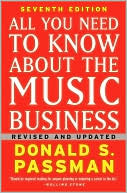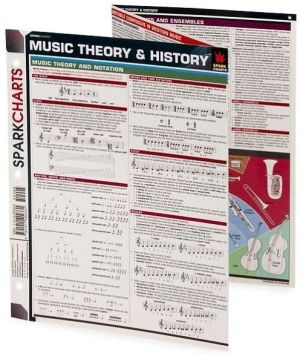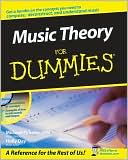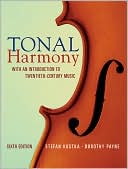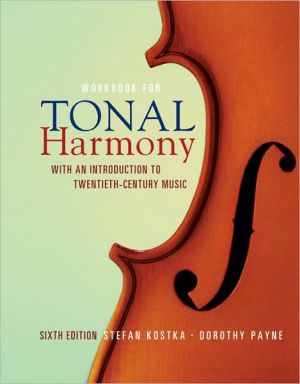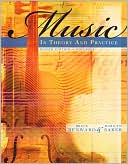Ear Training, Revised
Search in google:
Combining a proven technique with an effective and easy-to-use supplements package, Ear Training: A Technique for Listening is the ideal text for college aural skills courses. Its logical progression in the coverage of skills enables students to build gradually to full proficiency, while ensuring that material they learn early in the course remains fresh. Its flexibility makes it equally effective in a lab-based course, in a instructor-guided setting, or in a course that combines the two. For the revised edition, the online site developed in conjunction with Ear Training: A Technique for Listening has been totally revised to provide a reliable and user-friendly environment for drill and practice of the skills developed in the text. Activities such as melodic dictation, interval detection, chord quality identification, and rhythmic error detection mirror similar exercises in the text and serve to reinforce a broad range of aural skills.
PrefaceUnit 1Melody 1A Melodic Dictation: Scalewise (Conjunct Diatonic) MelodiesMelody 1B Mode Identification: Major and Harmonic Minor ScalesMelody 1C Scale Degree Identification: Single NotesMelody 1D Intervals: m2, M2, m3, M3Melody 1E Models and Embellishments: Short Melodic StructuresHarmony 1A Chord Function Identification: I and V TriadsHarmony 1B Chords in Music Literature: I and V TriadsHarmony 1C Harmonic RhythmHarmony 1D Triad Position Identification: Major and Minor TriadsHarmony 1E Chord Quality Identification: Major and Minor TriadsHarmony 1F Triad Factors in the SopranoRhythm 1A Rhythmic Dictation: Rhythm Including Half- Beat ValuesUnit 2Melody 2A Melodic Dictation: Melodies Using m2, M2, m3, M3Melody 2B Mode Identification: Major and Three Forms of the Minor ScaleMelody 2C Scale Degree Identification: Two NotesMelody 2D New Intervals: P5 and P4Melody 2E Models and Embellishments: Descending Thirds in Two VoicesHarmony 2A Chord Function Identification: I, IV, and V TriadsHarmony 2B Chords in Music Literature: I, IV, and V TriadsHarmony 2C Nonharmonic Tones: IntroductionHarmony 2D Triad Position Identification: Major and Minor TriadsHarmony 2E Chord Quality Identification: Major, Minor and Diminished TriadsHarmony 2F Triad Factors in the Soprano and BassRhythm 2A Rhythmic Dictation: Duple and Triple Subdivisions of the BeatUnit 3Melody 3A Melodic Dictation: Melodies Using m2, M2, m3, M3, P4, P5Melody 3B Error Detection: Scalewise Melodies with ErrorsMelody 3C Scale Degree Identification: Three NotesMelody 3D Interval Review: m2, M2, m3, M3, P4, P5Melody 3E Models and Embellishments: Simple Melodic StructuresHarmony 3A Chord Function Identification: I, ii, and V TriadsHarmony 3B Chords in Music Literature: I, ii, and V TriadsHarmony 3C Cadence Identification: Cadence TypesHarmony 3D Harmonic Dictation: I(i), IV(iv), and V Triads in Four-Part PhrasesHarmony 3E Chord Quality Identification: Writing Major, Minor, Diminished, and Augmented TriadsRhythm 3A Rhythmic Dictation: Rhythmic Figures Including Half-Beat ValuesRhythm 3B Error Detection: Dotted Rhythm ValuesUnit 4Melody 4A Melodic Dictation: Scalewise Melodies and Arpeggiations of I and VMelody 4B Error Detection: Errors in Melodies Outlining the I, IV, and V TriadsMelody 4C Scale Degree Identification: Three NotesMelody 4D New Intervals: m6, M6Melody 4E Models and Embellishments: 5-6 Patterns in Two VoicesHarmony 4A Chord Function Identification: I, ii, IV, and V TriadsHarmony 4B Chords in Music Literature: I, ii, IV, and V TriadsHarmony 4C Nonharmonic Tones: Two-Voice ExamplesHarmony 4D Harmonic Dictation: I(i), ii, IV(iv), and V Triads in Chorale PhrasesHarmony 4E Chord Quality Identification: Major, Minor, Diminished, and Augmented TriadsRhythm 4A Rhythmic Dictation: Half-Beat Values in SyncopationRhythm 4B Error Detection: Half-Beat Values in SyncopationUnit 5Melody 5A Melodic Dictation: Melodies Outlining the I, IV, V (and vii06) TriadsMelody 5B Error Detection: Excerpts from Music LiteratureMelody 5C Melodic Figure Identification: Sequence and Rhythmic Repetition Melody 5D New Interval: The TritoneMelody 5E Models and Embellishments: Descending 6ths in Two VoicesHarmony 5A Chord Function Identification: I(i), ii (ii0), IV(iv), and V Triads and InversionsHarmony 5B Chords in Music Literature: I(i), ii(ii0), IV(iv) and V TriadsHarmony 5C Harmonic Rhythm and Nonharmonic TonesHarmony 5D Harmonic Dictation: I(i), ii, IV(iv), and V Triads in Chorale PhrasesHarmony 5E Error Detection: Single Triads in Four PartsRhythm 5A Rhythmic Dictation: Introduction to Quarter- Beat ValuesRhythm 5B Error Detection: Quarter-Beat ValuesUnit 6Melody 6A Melodic Dictation: Intervals of a 7thMelody 6B Error Detection: Schubert MelodiesMelody 6C Melodic Figure Identification: Sequence, False Sequence, and Rhythmic RepetitionMelody 6D New Intervals: m7 and M7Melody 6E Models and Embellishments: 7-3 Pattern in Two VoicesHarmony 6A Chord Function Identification: I, ii, IV, V, and vi TriadsHarmony 6B Chords in Music Literature: Emphasis on ii, IV, and viHarmony 6C Nonharmonic Tones: Four-Voice ExamplesHarmony 6D Harmonic Dictation: The I(i), ii(ii0), IV (iv) and V Triads in Chorale PhrasesHarmony 6E Error Detection: Triads in Fourt PartsRhythm 6A Rhythmic Dictation: Quarter-Beat ValuesRhythm 6B Error Detection: Triplet FiguresUnit 7Melody 7A Melodic Dictation: Two-Phrase MelodiesMelody 7B Error Detection: Handel MelodiesMelody 7C Melodic Figure Identification: Melodic DevicesRhythm 7D Intervals: All Diatonic IntervalsMelody 7E Models and Embellishments: Cadence Formulas in Two VoicesHarmony 7A Chord Function Identification: I(i), ii (ii0), iii(III,III+) IV(iv), V, and vi(VI) TriadsHarmony 7B Chords in Music Literature: Emphasis on iii and viHarmony 7C Harmonic Rhythm and Harmonic Analysis: I, ii, IV, V, and vi TriadsHarmony 7D Harmonic Dictation: I(i), ii(ii0), IV(iv), V, and vi(VI) Triads in Chorale PhrasesHarmony 7E Error Detection: Triads in Four PartsRhythm 7A Rhythmic Dictation: Quarter-Beat ValuesRhythm 7B Rhythmic Dictation: Beat Units Divided into TripletsUnit 8Melody 8A Melodic Dictation: Melodies with Larger LeapsMelody 8B Error Detection: Franck MelodiesMelody 8C Harmonic Rhythm, Harmonic Analysis, Sequences, Phrase Relationships, and CadencesMelody 8D Intervals: All Diatonic IntervalsMelody 8E Models and Embellishments: 5-6 Patterns in Three VoicesHarmony 8A Chord Function Identification: Diatonic Triads (Major Mode)Harmony 8B Chords in Music Literature: All TriadsHarmony 8C Nonharmonic Tones: Bach Chorales (1)Harmony 8D Harmonic Dictation: I(i), ii, IV(iv), V, vi (VI), and Vii0 Triads in Chorale PhrasesHarmony 8E Error Detection: Triads in Four PartsRhythm 8A Rhythmic Dictation: Quarter-Beat ValuesRhythm 8B Error Detection: Quarter-Beat ValuesUnit 9Melody 9A Melodic Dictation: Short Melodies from Music LiteratureMelody 9B Error Detection: Bach MelodiesMelody 9C Melodic Dictation: Two-Part DictationMelody 9D Intervals: Harmonic Intervals of the m3, Tritone, P5, m6, M6, m7Melody 9E Models and Embellishments: Descending First Inversion TriadsHarmony 9A Chord Function Identification: Six-Four ChordsHarmony 9B Chords in Music Literature: Six-Four ChordsHarmony 9C Harmonic Rhythm and Harmonic Analysis of Folk MelodiesHarmony 9D Harmonic Dictation: All Diatonic Triads in Chorale PhrasesHarmony 9E Error Detection: Triads in Four PartsRhythm 9A Rhythmic Dictation: Compound Meters with Quarter-Beat ValuesUnit 10Melody 10A Melodic Dictation: SequencesMelody 10B Error Detection: Themes from Music Literature Lacking AccidentalsMelody 10C Two-Voice DictationMelody 10D Intervals: All Intervals Played HarmonicallyMelody 10E Models and Embellishments: 7th Chord Patterns in Three VoicesHarmony 10A Chord Function Identification: Dominant 7th ChordsHarmony 10B Chords in Music Literature: Dominant 7th Chords (All Inversions)Harmony 10C Nonharmonic Tones: Bach Chorales (2)Harmony 10D Harmonic Dictation: The Dominant 7th Chord in Chorale PhrasesHarmony 10E Error Detection: Triads or Dominant 7th ChordsRhythm 10A Rhythmic Dictation: Triple and Triplet SubdivisionsRhythm 10B Rhythmic Dictation: Two-Voice RhythmsUnit 11Melody 11A Melodic Dictation: Short Melodies That Modulate to Closely Related KeysMelody 11B Error Detection: Excerpts from Music LiteratureMelody 11C Phrase Relationships and CadencesMelody 11D Intervals: All Intervals Played HarmonicallyMelody 11E Models and Embellishments: Chord Progression with Melodic EmbellishmentsHarmony 11A Chord Function Identification: vii07 (Deminished 7th Chord)Harmony 11B Chords in Music Literature: vii07 (Diminished 7th Chord)Harmony 11C Aural Analysis: Aspects of Two-Phrases That ModulateHarmony 11D Harmonic Dictation: Chorale Phrases That ModulateHarmony 11E Chord Quality Identification: MM, Mm, mm, dm, and dd 7th ChordsRhythm 11A Rhythmic Dictation: The QuartoletRhythm 11B Error Detection: More Difficult Rhythmic ErrorsUnit 12Melody 12A Melodic Dictation: Modulations to Closely Related KeysMelody 12B Error Detection: Two-Voice CompositionsMelody 12C Binary, Rounded Binary, and Three-Part FormMelody 12D Interval Dictation: Two Intervals in SuccessionMelody 12E Models and Embellishments: I-V-I Progression with Melodic EmbellishmentsHarmony 12A Chord Function Identification: Nondominant 7th ChordsHarmony 12B Chords in Music Literature: Nondominant 7th ChordsHarmony 12C Aural Analysis: Harmonic and Melodic Relationships in Musical Periods from Haydn SonatasHarmony 12D Harmonic Dictation: Modulations to Closely Related KeysHarmony 12E Chord Quality Identification: MM, Mm, mm, dm, and dd 7th ChordsRhythm 12A Rhythmic Dictation: Eighth-Beat ValuesRhythm 12B Error Detection: Eighth-Beat ValuesUnit 13Melody 13A Melodic Dictation: Modulation in Two-Phrase PeriodsMelody 13B Error Detection: Brahms MelodiesMelody 13C Binary, Rounded, Binary, and Three-Part FormMelody 13D Interval Dictation: Two and Three Intervals in SuccessionMelody 13E Models and Embellishments: I-V-I Progression with Diatonic Melodic EmbellishmentsHarmony 13A Chord Function Identification: Secondary Dominants of V and iiHarmony 13B Chords in Music Literature: Secondary Dominants of ii, IV, and VHarmony 13C Aural Analysis: Key, Phrase, and Cadence Relationships in Musical ExcerptsHarmony 13D Harmonic Dictation: Chorale Phrases Containing 7th ChordsHarmony 13E Error Detection: Triads and 7th ChordsRhythm 13A Rhythmic Dictation: Introduction to the SupertripletRhythm 13B Error Detection: Eighth-Beat ValuesUnit 14Melody 14A Melodic Dictation: Modulation in Two-Phrase MelodiesMelody 14B Error Detection: Excerpts from Music LiteratureMelody 14C Mode Identification: Dorian, Phrygian, Lydian, and Mixolydian ModesMelody 14D Interval Dictation: Three Intervals in SuccessionMelody 14E Models and Embellishments: I-V-I Progression with Chromatic Melodic EmbellishmentsHarmony 14A Chord Function Identification: Secondary Dominants of IV(iv) and vi(VI)Harmony 14B Chords in Music Literature: Secondary Dominants and Leading Tone Chords of iii and IVHarmony 14C Aural Analysis: Four-Phrase Excerpt from a Beethoven Piano SonataHarmony 14D Harmonic Dictation: Chorale Phrases Containing Secondary Dominants Harmony 14E Error Detection: Triads and 7th ChordsRhythm 14A Rhythmic Dictation: Subtriplet in Simple and Compound MeterRhythm 14B Error Detection: Subtriplet in Simple and Compound MeterUnit 15Melody 15A Melodic Dictation: Nondiatonic TonesMelody 15B Error Detection: Five Note Melodic FiguresMelody 15C Mode Identification: Dorian, Phrygian, Lydian, Mixolydian and Aeolian ModesMelody 15D Interval Dictation: Adding Proper Accidentals to Modal MelodiesMelody 15E Models and Embellishments: Harmonic Structure with Melodic and Harmonic EmbellishmentsHarmony 15A Chord Function Identification: All Secondary DominantsHarmony 15B Chords in Music Literature: All Secondary Dominants and Leading Tone ChordsHarmony 15C Aural Analysis: Phrase, Key, Cadence, and Harmonic Relationships in a Five-Phrase Excerpt from a Beethoven Piano SonataHarmony 15D Harmonic Dictation: Modulation in Chorale PhrasesHarmony 15E Error Detection: Triads and 7th ChordsHarmony 15F Identifying Modulations to Closely Related and Foreign KeysRhythm 15A Rhythmic Dictation: More Difficult RhythmsRhythm 15B Error Detection: More Difficult Rhythmic ErrorsUnit 16Melody 16A Melodic Dictation: Nondiatonic TonesMelody 16B Error Detection: Short Melodic Segments Based on IntervalsMelody 16C Melodic Dictation: Typical Blues FiguresMelody 16D Interval Dictation: Two-Voice Modal CompositionsMelody 16E Models and Embellishments: Harmonic Structure with Melodic and Harmonic EmbellishmentsHarmony 16A Chord Function Identification: German and French Augmented 6th Chords and the Neapolitan 6th ChordsHarmony 16B Chords in Music Literature: Neapolitan 6th Chords and Augmented 6th ChordsHarmony 16C Aural Analysis: Binary, Rounded Binary, and Three-Part FormsHarmony 16D Harmonic Dictation: Chorale Phrases Containing Neapolitan 6th and Augmented 6th ChordsHarmony 16E Error Detection: Triads and 7th Chords Rhythm 16A Rhythmic Dictation: Changing MetersRhythm 16B Error Detection: Review


